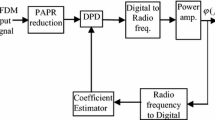Abstract
This study primarily integrated the techniques of selected mapping (SLM), constellation extension (CE), and Reed–Muller codes (RM codes) to construct an improved SLM technique termed RM-CE-SLM. A high peak-to-average power ratio (PAPR) is the primary disadvantage of orthogonal frequency division multiplexing (OFDM) systems. High PAPR not only reduces the performance of high-power amplifiers, but also increases the complexity of digital-to-analog converters. The RM-CE-SLM technique is primarily used to improve the high PAPR phenomenon of OFDM systems. The RM-CE-SLM technique initially uses RM codes to select the internal and external positions of constellation points in a 16 quadrature amplitude modulation (16-QAM) CE diagram. The technique also uses codeword elements in cyclic codes to produce the SLM scrambling sequence. The elements of a scrambling sequence are based on the codeword elements in cyclic codes, which determine whether to scramble the symbols after data are modulated. Symbol scrambling becomes the external constellation points in a 16-QAM CE diagram. The simulation results showed that PAPR performance in the RM-CES-SLM technique was superior to that of the traditional SLM technique. In addition, the proposed technique has an error correction capability, and does not require the transmission of additional side information.







Similar content being viewed by others
References
ETSI. (1995). Radio broadcasting system: digital audio broadcasting to mobile, portable and fixed receivers. European Telecommunication Standard, ETS 300–401.
ETSI. (1997). Digital video broadcasting: framing structure, channel coding, and modulation for digital terrestrial television. European Telecommunication Standard 1997. ETS 300–744.
IEEE 802.11. (1997). IEEE standard for wireless LAN medium access control (MAC) and physical layer (PHY) specifications. IEEE standard.
Kulkarni, V. M., & Bhalchandra, A. S. (2012). An overview of various techniques to reduce the Peak-to-average power ratio in multicarrier transmission systems. In Proceedings of the 2012 IEEE ICCIC, Coimbatore, India, Dec 2012, pp. 1–5.
Jiang, T., & Wu, Y. Y. (2008). An overview: Peak-to-average power ratio reduction techniques for OFDM signals. IEEE Transactions on Broadcasting, 54(2), 257–268.
Jeon, H. B., No, J. S., & Shin, D. J. (2011). A low-complexity SLM scheme using additive mapping sequences for PAPR reduction of OFDM signals. IEEE Transactions on Broadcasting, 57(4), 866–875.
Badran, E. F., & El-Helw, A. M. (2011). A novel semi-blind selected mapping technique for PAPR reduction in OFDM. IEEE Signal Processing Letters, 18(9), 493–496.
Wang, L., & Liu, J. (2011). PAPR reduction of OFDM signals by PTS with grouping and recursive phase weighting methods. IEEE Transactions on Broadcasting, 57(2), 299–306.
Taspinar, N., Kalinli, A., & Yildirim, M. (2011). Partial transmit sequences for PAPR reduction using parallel tabu search algorithm in OFDM systems. IEEE Communications Letters, 15(9), 974–976.
Kou, Y. J., Lu, W.-S., & Antoniou, A. (2007). A new peak-to-average power-ratio reduction algorithm for OFDM system via constellation extension. IEEE Transaction on Wireless Communications, 6(5), 1823–1832.
Wang, C. L., Tsai, Y. C., & Ku, S. J. (2009). A low-complexity constellation extension scheme for PAPR reduction of OFDM signals. In Proceedings of the 2009 IEEE VTC, Anchorage, Alaska, USA, May 2009, pp. 1–5.
Guan, L., Jiang, T., Zhou, Y., & Li, C. (2010). A Novel Constellation extension for reduction of peak-to-average-power radio in OFDM system. In Proceedings of the 2010 IEEE BMSB, Shanghai, China, March 2010, pp. 1–4.
Wang, C. L., Wang, S. S., & Huang, Y. C. (2011). An improved constellation extension scheme for PAPR reduction in OFDM systems. In Proceedings of the 2011 IEEE VTC, Budapest, Hungary, May 2011, pp. 1–4.
Guel, D., Palicot, J., & Louet, Y. (2010). Tone reservation technique based on geometric method for orthogonal frequency division multiplexing peak-to-average power ratio reduction. IET Communications, 4(17), 2065–2073.
Gazor, S., & AliHemmati, R. (2012). Tone reservation for OFDM sytems by maximizing signal-to-distortion ratio. IEEE Transactions on Wireless Communications, 11(2), 762–770.
Wang C. L., Tsai Y. C., & Ku S. J. (2009). A low-complexity constellation extension scheme for PAPR reduction of OFDM signals. In Proceedings of the 2009 IEEE VTC, Alaska, USA, Sept. 2009, pp. 1–5.
Wang C. L., Wang S. S., & Huang, Y. C. (2011). An improved constellation extension scheme for PAPR reduction in OFDM systems. In Proceedings of the 2011 IEEE VTC, Budapest, Hungary, May 2011, pp. 1–4.
Mac Williams, F. J., & Sloane, N. J. A. (1986). The theory of error-correcting codes. Amsterdam: North-Holland.
Author information
Authors and Affiliations
Corresponding author
Rights and permissions
About this article
Cite this article
Liang, HY. Integrating CE and Modified SLM to Reduce the PAPR of OFDM Systems. Wireless Pers Commun 80, 709–722 (2015). https://doi.org/10.1007/s11277-014-2036-0
Published:
Issue Date:
DOI: https://doi.org/10.1007/s11277-014-2036-0




